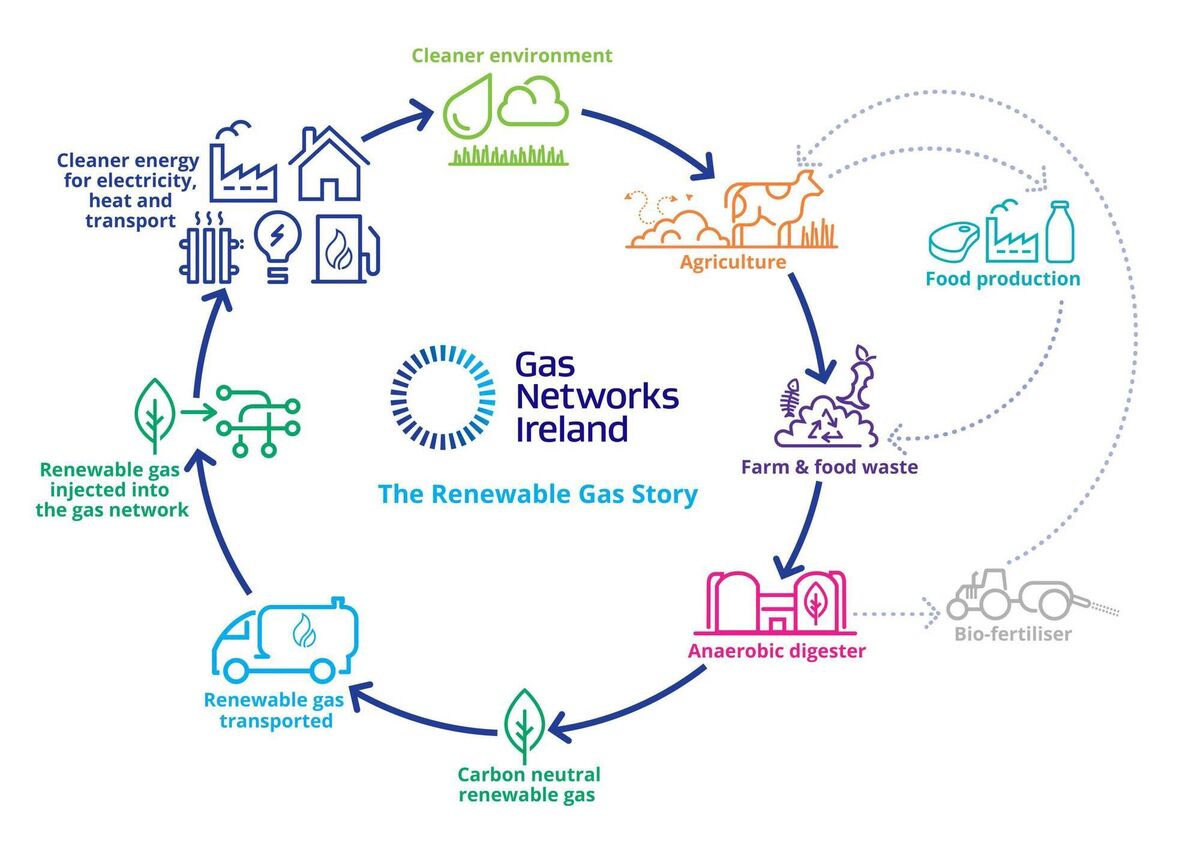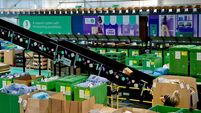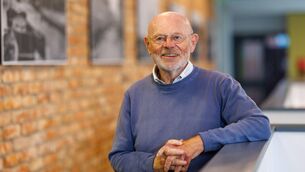GNI’s pathway to Net Zero: The role of biomethane and green hydrogen

Gas Networks Ireland's hydrogen technical manager, Wayne Mullins, showing a demo model of hydrogen generation through electrolysis to chief executive, Hydrogen Ireland, Paul McCormack and head of customer care and communications, Gas Networks Ireland, Kate Gannon.
Hydrogen, with just one proton and one electron — making it the only element without a neutron — is the simplest and most abundant element in the observable universe.
Helium follows closely. Together, these two elements dominate the cosmos, accounting for approximately 99 per cent of all atoms, according to the Harvard-Smithsonian Center for Astrophysics.
When burned, hydrogen produces energy and water. Traditionally, this process relied on fossil fuel-generated energy. The production of green hydrogen is different, in that it requires an electrolyzer-a device that splits water molecules into hydrogen and oxygen using renewable energy. Since the production of green hydrogen does not emit carbon gases or harmful by-products, it is hoped that it will eventually replace fossil fuels in heavy transport.
There is precedent for this: Zero-emissions fertiliser is already being produced in Spain, where hydrogen is used to create ammonia, a key ingredient in fertiliser production.
Gas Networks Ireland, regulated by the Commission for Regulation of Utilities, owns and operates Ireland’s €3 billion, 14,725 km national gas network. Its infrastructure supplies more than 30 per cent of Ireland’s total energy needs, 40 per cent of all heating requirements, and nearly 50 per cent of electricity generated from gas. The network is considered to be one of the safest and most modern in Europe.
While the European Commission aims to produce up to 10 million tonnes of renewable hydrogen within the EU by 2030 and to import another 10 million tonnes, progress has been slow.
In 2022, Europe produced just 20,000 tonnes of renewable hydrogen. This was a year in which 96 per cent of the hydrogen used across the continent came from natural gas. In July 2023 the European Court of Auditors declared those targets to be "unrealistic."

Despite the slow progress, there have been positive developments. The fact that the agricultural sector must cut emissions by 25 per cent by 2050 is likely a catalyst in generating inspiring endeavours for change: 2023 saw reduced nitrogen fertiliser use lead to a 4.6 per cent drop in agricultural emissions, and HEINEKEN Spain became the first company to brew beer using barley grown with "Impact Zero" fertilisers.
Spain is also addressing food security and natural gas supply challenges through a number of projects, including that of the company FertigHy, which is supporting the decarbonisation strategies of leading food and beverage companies by providing low-carbon fertilisers that help meet sustainability goals, by building large-scale, low-carbon fertiliser plants. Sustainability, self-sufficiency, and supply security are key drivers behind the initiatives aiming to decarbonise fertiliser production.
In Norway, the fertiliser company, Yara, has signed a deal with PepsiCo, to supply up to 165,000 tons of low-carbon fertilisers per year to around 1,000 farms across the EU and the UK. The tonnage will cover around 25 per cent of PepsiCo’s crop fertiliser requirements in Europe, with the initial focus being on potato crops before moving onto oats and corn. All going well, the intention is to supply PepsiCo with all of its fertiliser-produced from renewable or CCS-based ammonia- by 2030.
In a promising development at home, farmers in Ireland have been making progress in reducing emissions, with chemical nitrogen use in 2023, down 31 per cent compared with 2018.
According to the International Renewable Energy Agency, hydrogen could account for up to 12 per cent of global energy use by 2050. Gas Networks Ireland’s roadmap, ‘Pathway to a Net Zero Carbon Gas Network,’ envisions transforming Ireland's gas network into two separate systems carrying 100 per cent renewable gas: with one for biomethane and the other for green hydrogen. This repurposed network may also support energy exports in the future.
Biomethane, a carbon-neutral renewable gas produced from farm and food waste, is already compatible with existing gas infrastructure. Although current volumes are low, they are increasing.
Ireland’s biomethane industry is still in its early stages compared to countries like France, the Netherlands, and Denmark. The Irish Government has committed to biomethane supplying 10 per cent of the country’s gas needs by 2030. Ireland has the highest potential per capita to produce biomethane in an industry that could decarbonise agriculture while supporting rural communities.
Confirming that Gas Networks Ireland is actively working to enable Ireland’s biomethane industry and its increased supply to the national gas grid, Gas Networks Ireland’s Director of Strategy and Regulation, Edwina Nyhan continues: “One of the most significant projects currently underway is the development of a biomethane central grid injection facility in Mitchelstown, County Cork. This will enable biomethane production plants to transport their indigenously produced renewable gas to the facility and inject it into the gas network, ensuring that renewable gas reaches homes, businesses, and industries across Ireland.”
In May, Gas Networks Ireland partnered with Bia Energy to inject renewable biomethane-produced from food waste at Bia’s €60 million anaerobic digestion facility in Huntstown, County Dublin-in to the national gas network.
Like biomethane, green hydrogen is set to play a crucial role in delivering clean energy to Ireland. Hydrogen is already used in oil refining and ammonia production for fertilisers, but as industries decarbonise, the demand for green hydrogen will increase, particularly in steel and cement production.
However, challenges remain. According to MIT Energy Initiative research reported on MIT's Climate Portal, hydrogen’s small molecular size and tendency to leak from pipelines make it difficult to transport using existing natural gas infrastructure. Hydrogen also causes "embrittlement" in certain steel alloys, making pipelines prone to cracking.
Here at home, Gas Networks Ireland is conducting research with University College Dublin to ensure the Irish gas network can handle hydrogen blends, and early findings suggest that up to 20 per cent hydrogen can be safely blended with natural gas.

Gas Networks Ireland’s Pathway to a Net Zero Carbon Network outlines four phases, with the ultimate goal of fully decarbonising the gas network by 2045-five years ahead of Ireland's national goal. The current foundation phase (2023–2027) focuses on infrastructure for biomethane and pilot projects for hydrogen blending. By 2035, Gas Networks Ireland plans to scale up biomethane and hydrogen use, aiming to meet the government’s 2030 biomethane targets.
By 2040, hydrogen is expected to account for nearly half of the gas in the network, with biomethane contributing 38 per cent. By 2045, the network will run entirely on renewable gases, ensuring a clean, sustainable energy future for Ireland.
Replacing fossil gas with biomethane and green hydrogen is central to Gas Networks Ireland’s vision. Biomethane offers an immediate solution, while green hydrogen has the potential to revolutionise the energy system, ensuring Ireland’s transition to a cleaner, more sustainable future.
Edwina Nyhan says: “Ireland’s gas network will help Ireland reach net zero, as it evolves to transport 100 per cent renewable gases over the next twenty years. By repurposing the gas network, we are not only supporting the State’s climate and energy targets, but also ensuring a reliable and affordable energy supply for the nation.
“Our recently published Pathway brings to life, our vision to be at the heart of Ireland’s energy future and outlines a route by which the gas network can transition to net zero.
“Inevitably, some aspects will evolve as we move forward. However, we will remain flexible and responsive to achieve our commitment to delivering for Ireland. This roadmap will enable us to transition sequentially and ensure a robust and adaptive approach to achieving a fully decarbonised network over time."














